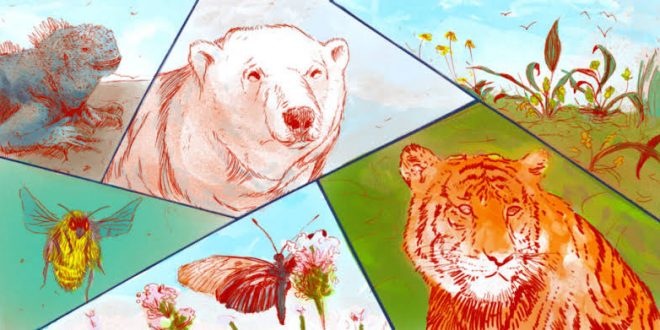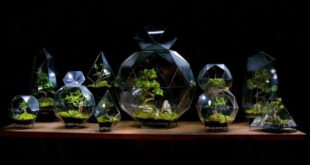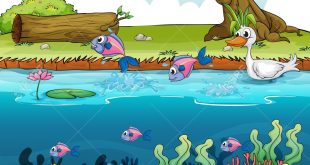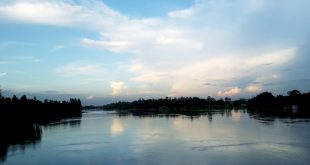There are three main components/types of biodiversity:
(1) genetic.
(2)organismal/taxonomic.
(3) ecological.
(1) genetic & sub-cellular: Biodiversity expressed within individual cells and non-cellular organisms (e.g., viruses)
– diversity of genetic information central to this category but variety of metabolic pathways & molecular biology of life also important.
(2) taxonomic diversity: focused on sp., at which organisms classified, additional information on diversities about Kingdom, Division, Class, Order, families, genus, Species, agricultural traits etc.
(3) ecological diversity: includes whole communities, habitats, ecosystems etc.
Other than this:
Cultural biodiversity: dependency of human sociological system upon ecological system (e.g., whaling for Makah Indians & small Norwegian coastal town).
Interaction biodiversity: interaction among species as fundamental important factor in natural system.
Genetic & Subcellular
Raw material and basis from which future biodiversity emerges, controls expression and deviation of particular feature of living organisms (e.g. hair, eye color in human, etc.)
Best safe and secure cloud storage with password protection
Get Envato Elements, Prime Video, Hotstar and Netflix For Free
Best Money Earning Website 100$ Day
#1 Top ranking article submission website
Gene:
– An element of the germplasm having a specific function in inheritance.
– Determined by specific sequence of purine and pyrimidine bases in DNA or sometimes in RNA.
– Serves to control transmission of hereditary character by specifying structure of particular protein or by controlling function of other genetic material.
Genetic biodiversity: Methods and measures
Methods:
• Protein electrophoresis: Widely used since the 1960s. This technique analyses the-different proteins which in turn reflect the different alleles in an individual.
• Restriction site mapping: A recent advance relying on very specific bacterial enzymes that restrict viral damage to DNA by cutting out damage at specific points. Analysis of these cut points, called restriction sites, allows very precise analysis of gene sequences.
• DNA and RNA sequencing: Another new approach allowing analysis of all DNA. A
frequent alternative is ribonucleic acid (RNA) found in ribosomes (RRNA). Ribosomes are
cell organelles that read genetic data and manufacture proteins based on these instructions. 16s rRNA (the name refers to the number of subunits in the RNA and that it is ribosomal) has been particularly important.
Measures:
– Percent polymorphic loci, P A locus is the position of a gene on the genome. A gene
where the frequency of the most common allele is <95 per cent of the total is regarded as polymorphic.
– Number of alleles, N This measures not only if a gene is polymorphic but also the number of alleles per gene.
• Heterozygocity, H Frequency of alleles. How inany there are and the frequency of each.
e.g. there may be three alleles. one occurring 85 per cent of the time. a second 10 per cent.
a third 5 per cent.
• Nuniber of segregating sites, S Restricion site positions can vary in a gene. This detail
can be added to the first three items.
– Allele tree: An attempt to construct evolutionary relationships. providing a sense of relatedness and uniqueness. In much the same way as a rare species can be picked out from among its more common kin, allele trees try to pick out the genetically unusual.
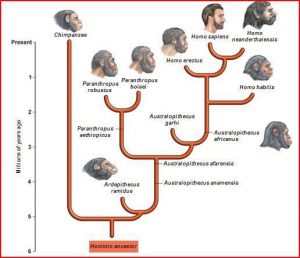
Microbial metabolic diversity
Tapping environmental energy sources: Energy from inorganic chemistry (chemoautotrophy):
• Sulphur bacteria: Oxidise sulphur compounds. e.g. hydrogen sulphide, to release energy used to build carbon-based food.
• Iron bacteria: Oxidise iron compounds, e.g. iron ore, to release energy used to build
carbon-based food.
• Nitrifying bacteria: Oxidise ammonia to release energy used to build carbon-based food. Nitrite and nitrate byproducts are a valuable input of nitrogenous plant nutrients.
• Hydrogen bacteria: Oxidise hydrogen to release energy used to build carbon-based
food.
Trap light energy (photoautotrophy or photosynthesis):
• Athiorhodacea: Split organic matter as hydrogen ion donor.
• Purple and green sulphur bacteria: Split hydrogen sulphide as hydrogen ion donor. Waste product is sulphur dioxide.
• Advanced photosynthesis: Split water as hydrogen ion donor. Waste product is oxygen.
(Note that many bacteria can trap energy by photosynthesis and by oxidation of inorganic
molecules. The ability to use either method is called mixotrophy.)
Metabolic energy release :
Anaerobic:
• Fermentation: Partial breakdown of carbon compounds.
• Anaerobic photosynthesis: Organic matter broken down as hydrogen donor for
photosynthesis generates energy.
• Nitrate reducers: Split oxygen off nitrate and nitrate. Nitrogen gas produced.
• Carbonate reducers: Split oxygen off common carbonate compounds, e.g. calcium
carbonate. Waste product. methane. has a possible role as a greenhouse gas.
• Sulphate reducers: Split oxygen from sulphate. Create rotten egg. hydrogen sulphide smell of fetid wetlands.
• Iron reducers: Alter chemical bonds of iron compounds resulting in energy release
analogous to oxygen splitting of other anaerobic systems but without oxygen.
Aerobic:
Oxidation of organic matter. Primary energy release systems for protistan, fungal, plant and animal kingdoms.
Nitrogen fixation: Bacteria extract atmospheric nitrogen gas and make it available to nitrogen cycle. Major
source of nitrogen input into ecosystems.
Taxonomic Diversity
- Species alive on earth is synonymous biodiversity.
- Systematics is that branch of biology. science responsible for recognizing, describing, classifying & naming organisms.
- Important task is taxonomic nomenclature, international code for naming exists for plants, animals, viruses & bacteria.
- Provides knowledge about evolution & relatedness of life (the phylogenetic classification)
Human natural tendency to classify things, biodiversity being no exception.
Classifications of life through European history
Classifications of life have changed over time, but even ancient systems can show precise methodologies and criteria. Changes reflect use of increasingly small-scale, internal features (internal organs, internal cell organelles, internal organelle RNA).
Greek Aristotle, in Historia Animalium, 486 BC. classified animals by clearly stated criteria for grouping animals together; (1) ‘With regard to animals there are those which have all their parts identical… specifically identical in form’ ; (2) ‘When other parts are the same but differ from one another by more or less, then they belong to animals of the same genos. By genos I mean for example bird or fish’ ; (3) ‘There also exist animals whose parts are neither the same by form but by analogy’.
Linnaeus The famed Swedish biologist tried a global classification of animals using multiple criteria. Life forms must be distinguished by external criteria. e.g. skin, locomotion. Each life form should have roughly equal roles in the economy of nature. Within each life form criteria used for subgroups should be essential for finding or processing food, e.g. teeth for mammals. beak for birds. Linneaus’ work resulted in classifications of plants based primarily on reproduction mechanisms and of animals based on feeding.
Cuvier Through the late eighteenth and early nineteenth century Cuvier pioneered comparative anatomy, especially the internal resemblance of animals, as a means of classification. Cuvier saw some characteristics as fundamentally more definitive than others, notably the nervous systems, though practicalities favoured use of bones. Cuvier broke the vision of animal life as a ladder of progression, splitting animals into four lineages (vertebrates, molluscs, articulates. e.g. insects and radiates) based on form and function. This split is still echoed in current classification of animal lineages.
Whittaker’s five kingdoms By the mid-twentieth century advances in cell biology led to a revision of life into five main kingdoms, defined primarily by subcellular features, eg. cell walls. links between cells, organelles and mechanisms of cell division. The five kingdom system (Monera. Protista, Fungi, Plantae. Animalia) is still widely used. (See Figure 3.1.)
16R rRNA By 1990 analyses of DNA and RNA. particularly work on 16s rRNA sequences suggested a fundamental revision of the five kingdoms. Shared and different 16s rRNA sequences suggested life divided into two main branches, the Bacteria on one hand and a second branch itself split between the Archaea (previously thought of as close allies of the Bacteria) and the Eucarya (everything else).
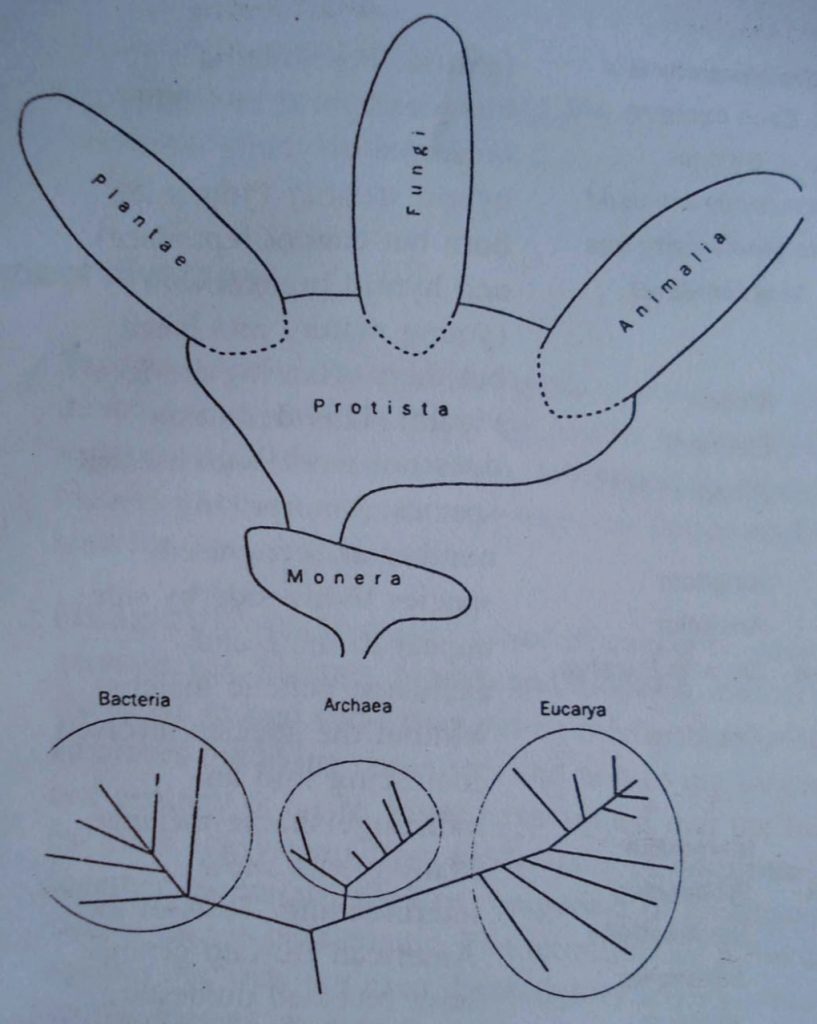
Ecological Diversity
?Covers – concepts of community, ecosystem, assemblage, habitats, biomes, etc.
?Also includes – high biodiversity hotspots, regions of endemism, continental & oceanic islands
?Classification of ecological diversity vary with scale:
– Global (biomes)
– Regional (practical definitions)
– National (presence or absence of precise species)
? Example of Ecological Diversity:
?Wetland – all areas of water within continental boundary including areas of marine water, depth of which at low tide does not exceed 6 m.
– On a global scale there are 9 types of main wetlands:
(1) Bogs – acidic, peat-building, H20 is derived from precipitation, present in cold climate, Sphagnum dominant plant.
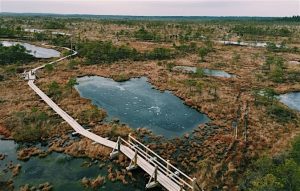
Source: https://en.m.wikipedia.org/wiki/Bog
(2) Fens – pH neutral or acidic, peat-building but with nutrients and hydrology influenced by surroundings.
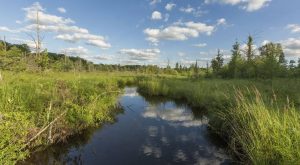
Source: https://en.m.wikipedia.org/wiki/The_Fens
(3) Swamps – waterlogged, trees and reeds present.
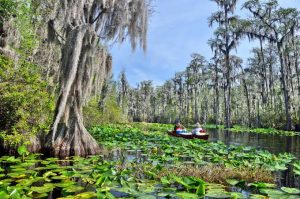
(4) Marsh – near seas, inundation occurs, little or no peat, herbaceous.
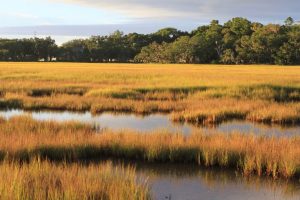
Source: https://pin.it/7N0Glbs
(5) Floodplains – periodic over-spill from lakes, rivers.

Source: https://geography.name/floodplain/
(6) shallow lakes – open water up to a few m deelake
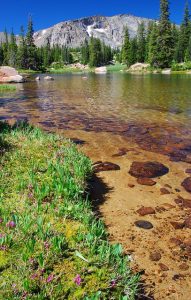
Source: https://pin.it/2vgjwlk
(7) salt marsh – tidal, herbaceous, occur in temperate latitudes.
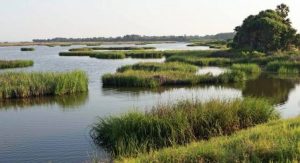
Source:https://www.greenvestus.com/2013/11/15/historic-ditching-effects-salt-marsh-structure/
(8) Mangroves – tidal woodlands, coastal, btwn 32°N & 30°S lats. mangrove trees domMangrove
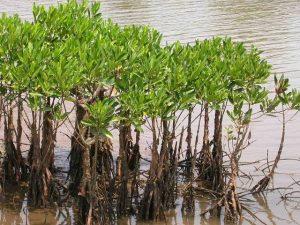
Source: https://en.m.wikipedia.org/wiki/Mangrove
(9) Anthropogenic – wetlands created by humans, e.g. paddies, dams, etc.
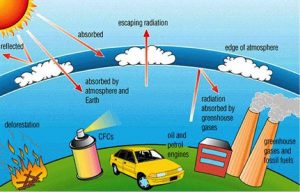
Source: https://pin.it/2Ezb0g8
Domestic Diversity
?Diversity in domesticated plants & animals, used not only for human food & commerce but also for religious, cultural & ritual purposes.
?Domestication leads to proliferation in cultivars (plants) & breeds (animals).
?Present day wheat, rice, cotton, jute, broiler, beef, fish, etc. are the cultivars & breeds of many wild stocks
?of 320,000 vas. plants. 500 domestic ,15-20 major crop species.
?50,000 vertbr.(excls. fish) 30-40 domosticated. 60 semi-domosticated, 200 fish in aquacult.
?4 insects domsticated for honey, silk, cochineal bug (a kind of dye; Mexico)
?Fungi- food, brewery, medicine, biotechnology.
?Estimated total of breeds variety: cattle 780-1090, sheeps 260-480, pigs 260-480.
?Core domesticated farm mammals (cow, buffalo, horse, ass, pig & sheep) comprise 3,237 breeds of which 474 rare, 617 extinct.
?Gene manipulation create new hybrids, impossible through natural selection.
?Gene incorporation among species now common.
?Transgenic species of sheep, cattle, horses & rodents are created to increase quality. Example – mouse genes control fur structure in sheep enhanced wool quality.
?Human gene application in animals for medicine.
?Global disease eradication cause lose of biodiversity.
Measuring Biodiversity
?Quantifying the variety and species richness on Earth is central to studies of biodiversity.
?Numerical data presented, a best guess, not definitive answer.
?more & more new species may be added.
?Birds & mammals are well documente.
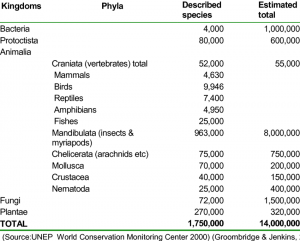
? Estimating the actual species :
?Many approaches have been used to estimate the actual total of species. Most involve using some data from a taxon, region or ecosystem & scaling up patterns to global proportions; some are:
1. Time series – by using rates of new species being added & then extrapolating the species.
2. Expert opinion – specialist with knowledge particular taxa can be asked.
3. Empirical relationships – by using original local data to global proportions; Erwin’s 30 mio species concept.
? Erwin’s famous 30 million species:
In 1982 entomologist Terry Erwin published a famed minimum estimate of species numbers, an astonishing 30 million. Erwin’s estimate was based on a study of the insect fauna found on Luehea seemannii, a canopy tree, in Panama. He used insecticide fog sprayed into the tree to knock down insects. He caught some 1.200 species of beetle, of which 162 were specific to the L seemannii tree. He then used a series of assumptions to reach a global estimate of tropical forest insect species richness. First, that there are 50,000 tropical forest tree species and that each would hartour 162 specialist beetle species. i.e. 8000000 beetles. Next, that canopy beetles represented 40 per cent of canopy arthropods so total canopy arthropods = 20000000 Finally, that there were twice as many canopy species as ground species, so add another 1000000 to reach the final 30000000 Erwin’s assumptions are rightfully open to criticism but the very magnitude of the estimate was enough to prompt resurgent interest in the inventory of life on Earth.
? Islands & Hot spots; Endemism, Earth’s extra special places:
?Biodiversity is not evenly distributed, certain ecosystem show striking concentration of species; identification of those places are necessary to understand the underlying causes that drive diversification.
?These foci can be special due to several factors:
– very high total species number,
– endemicity,
– unusual communities,
-super speciose taxa, etc.
?Megadiversity Countries – unusually rich in all form of diversity Example: Mexico, Columbia, Ecuador, Peru, Brazil, Zaire, Madagascar, China, India, Malaysia, Indonesia & Australia.
?18 global hot spots identified by endemicity of many taxa have been identhotspot
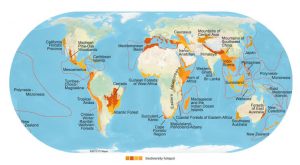
Source: https://www.e-education.psu.edu/geog30/node/393
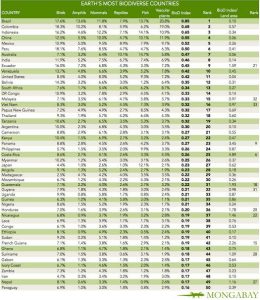
Source: https://news.mongabay.com/2016/05/top-10-biodiverse-countries/
? Oceanic Islands
?Support special species diversity, typically very isolated.
?Altitude create diverse habitat, temperate islands are often too exposed to extreme weather.
?Island wildlife has proven susceptible to extinction, because of several factors—
– population small,
– evolutionary innocence,
– lack of disturbance,
– human exploitation.
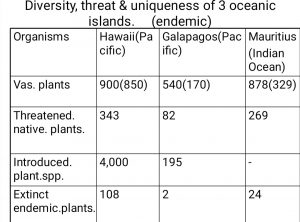
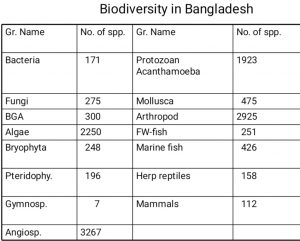
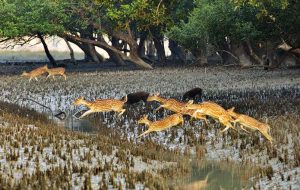
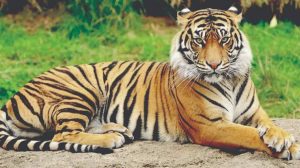
Source: https://bangladeshpost.net/posts/human-tiger-conflicts-decrease-in-sundarbans-14489
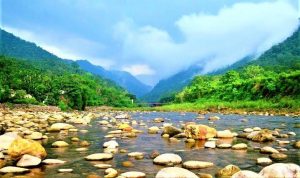

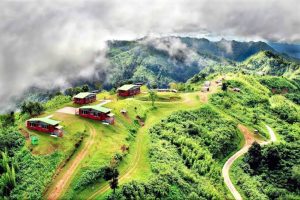
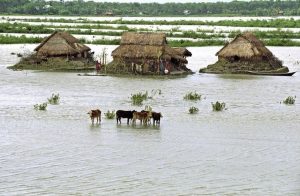
Source: https://pin.it/6CpZCca
Useful Links
- 10 Bog Plants to Help Filter Your Garden Pond by Happy DIY Home.
 Plantlet The Blogging Platform of Department of Botany, University of Dhaka
Plantlet The Blogging Platform of Department of Botany, University of Dhaka
